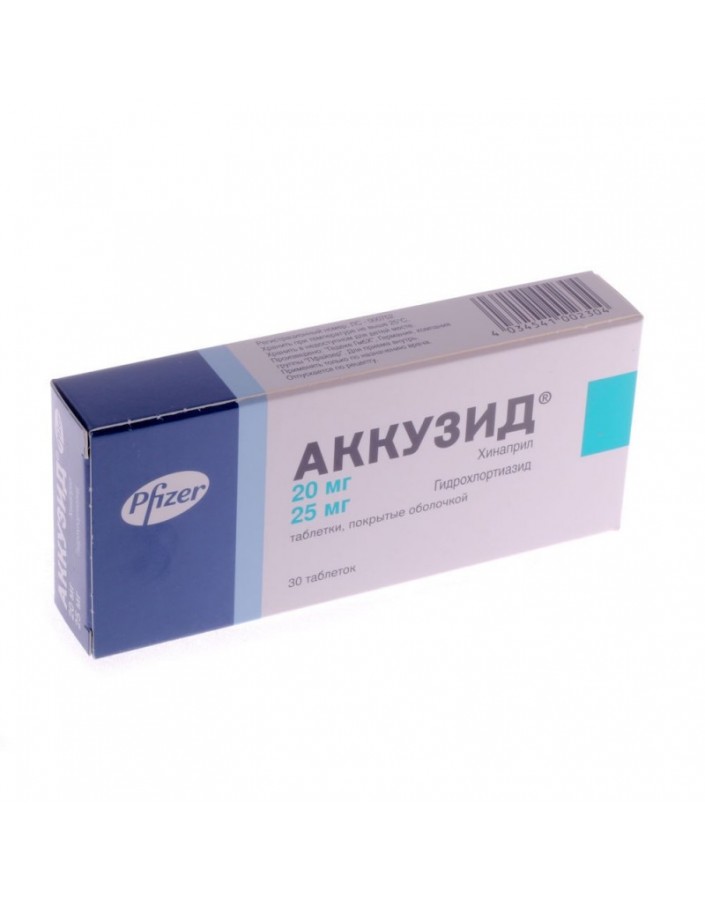




Security policy (edit with Customer reassurance module)

Delivery policy (edit with Customer reassurance module)

Return policy (edit with Customer reassurance module)
Coated Tablets pink, oval (triangular, round) biconvex, with a risk on both sides and marking "PD 222" on one side,
1 pill contains Quinapril (in the form of hydrochloride) 20 mg, hydrochlorothiazide 12.5 or 25 mg;
30 pieces per pack.
Accuzide is a combination antihypertensive drug that contains the ACE inhibitor quinapril and thiazide diuretic hydrochlorothiazide in three different ratios. Quinapril - an ACE inhibitor. ACE catalyzes the formation of angiotensin II, which has a vasoconstrictor effect and controls vascular tone, including by stimulating the secretion of aldosterone by the adrenal cortex. Quinapril inhibits circulating and tissue ACE and causes a decrease in vasopressor activity and aldosterone secretion. The elimination of the negative effect of angiotensin II on renin secretion by the feedback mechanism leads to an increase in plasma renin activity. At the same time, a decrease in blood pressure is accompanied by a decrease in OPSS and resistance of renal vessels, while changes in heart rate, cardiac output, renal blood flow, glomerular filtration rate and filtration fraction are insignificant or absent.In addition, quinapril somewhat reduces the loss of potassium caused by hydrochlorothiazide, which due to its diuretic effect also increases plasma renin activity, secretion of aldosterone, decreases serum potassium levels and increases its excretion with urine.
Hydrochlorothiazide is a diuretic that has a direct effect on the kidneys, increasing the excretion of sodium ions, chlorides, water, as well as potassium and bicarbonate ions, and reducing the excretion of Calcium ions. Although the mechanism of the antihypertensive effect of diuretics has not been fully studied, with their long-term use, there is a decrease in OPSS, probably due to a change in the exchange of sodium ions. Thus, the use of a combination of quinapril and hydrochlorothiazide leads to a more pronounced decrease in blood pressure than therapy with each drug separately.
Arterial hypertension (in patients for whom combination therapy with quinapril and diuretic is indicated).
For patients who do not receive a diuretic (regardless of whether monotherapy with quinapril was administered or not), the recommended initial dose of Accuzide is 10 mg + 12.5 mg 1 time per day. In the future, if necessary, the dose can be increased to 20 mg + 12.5 mg or up to the maximum recommended daily dose of 20 mg + 25 mg. The drug usually provides effective control of blood pressure in doses of 10 mg + 12.5 mg to 20 mg + 12.5 mg.
- angioedema in history as a result of prior therapy with ACE inhibitors;
- children and adolescents under 18 years of age (efficacy and safety of the drug have not been established);
- anuria;
- hypersensitivity to the drug;
- hypersensitivity to sulfanilamide derivatives.
- pregnancy and lactation
The most frequent side effects (> 1%) when taking any combination of quinapril and hydrochlorothiazide were headache (6.7%), dizziness (4.8%), cough (3.2%), which was usually unproductive, persistent and disappeared after discontinuation of therapy, increased fatigue (2.9%).
In general, side effects were mild and transient, not dependent on age, gender, race, and duration of therapy.
Accusid may cause symptomatic hypotension, but not more often than with monotherapy for both components of the drug. Symptomatic hypotension is rarely seen in the treatment of quinapril in patients with uncomplicated arterial hypertension, but it may develop as a result of therapy with ACE inhibitors in patients with reduced BCC, for example, after treatment with diuretics, with a diet with limited sodium intake or during hemodialysis. In the event of the appearance of symptomatic hypotension, the patient should be given a horizontal position and, if necessary, should be given a IV infusion using 0.9% sodium chloride solution. Transient arterial hypotension is not a contraindication to the further use of the drug, but in such cases it is advisable to reduce its dose.In patients with chronic heart failure, with or without kidney failure, therapy with an ACE inhibitor for hypertension can lead to an excessive decrease in blood pressure, which can be accompanied by oliguria, azotemia and, in rare cases, acute renal failure and even death. Treatment of such patients with Akkuzidom should begin under close medical supervision and supervision during the first 2 weeks and with an increase in the dose of the drug. In rare cases, therapy with ACE inhibitors may be accompanied by the development of agranulocytosis and suppression of bone marrow hematopoiesis in patients with uncomplicated arterial hypertension, but more often in patients with impaired renal function, especially with connective tissue diseases. In these cases, the number of leukocytes in the blood should be monitored. Thiazide diuretics sometimes cause worsening of SLE.
The drug should be kept out of the reach of children at a temperature not higher than 25 ° C.
Shelf life - 3 years.
Accusid